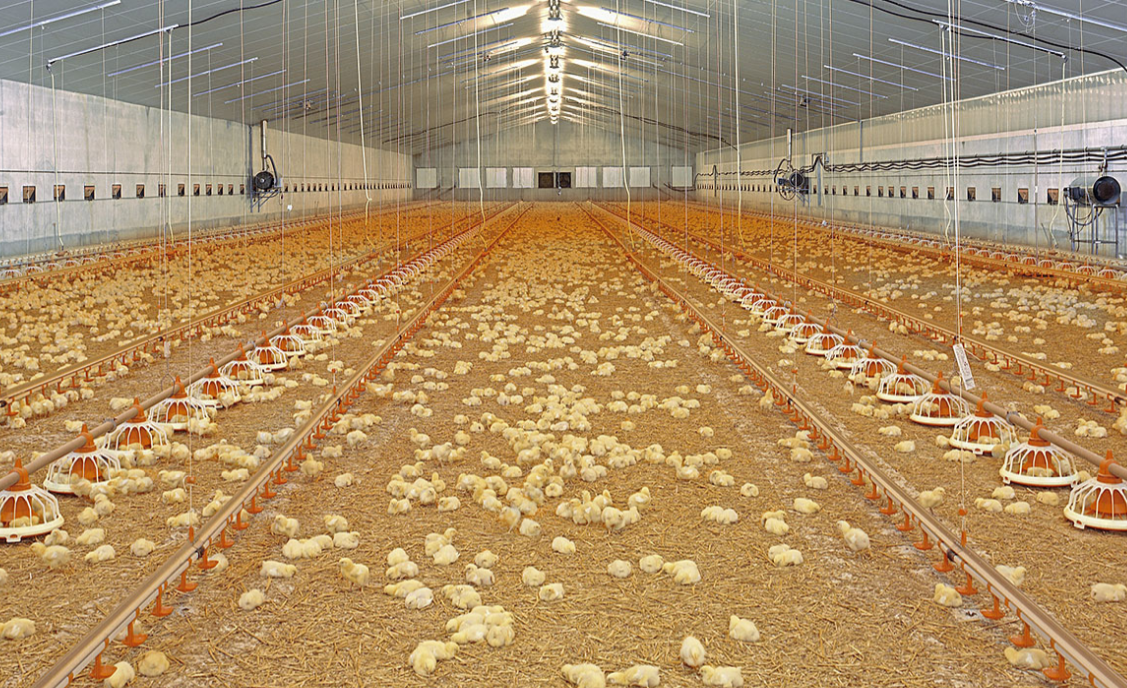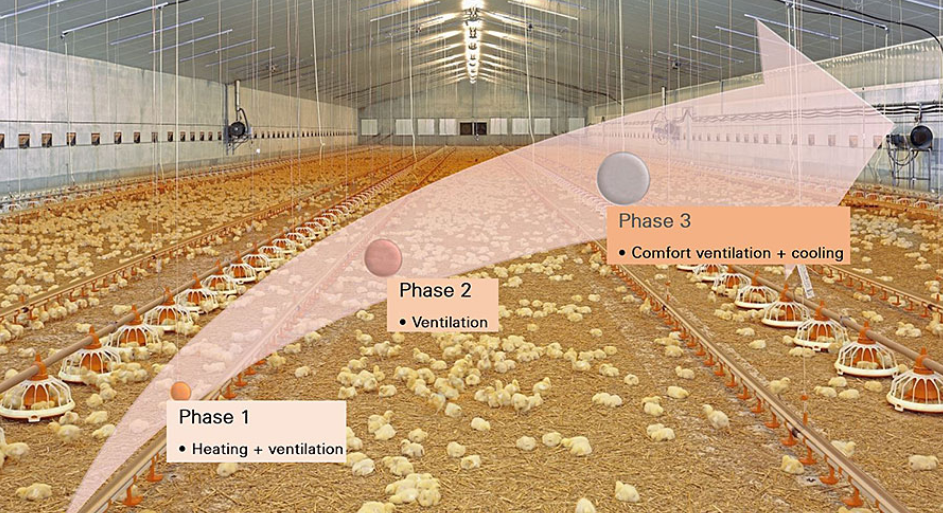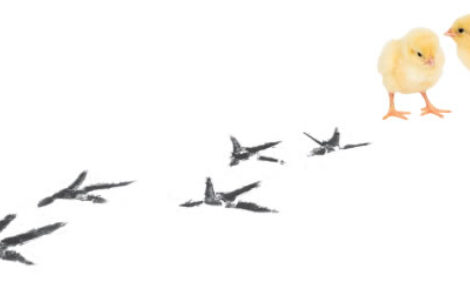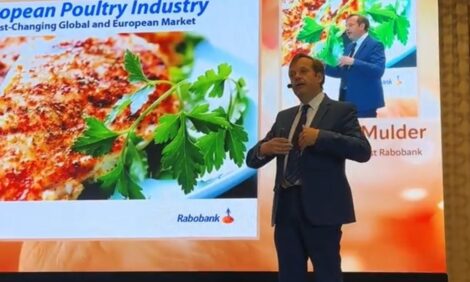



How to keep trouble from brewing in the broiler house

Climate computers are no different to any other computer: we only make use of a fraction of their features. In many cases, this fraction is enough. Concentrating on three phases for the house climate allows creating an interplay of air quality and temperature that is comfortable for poultry.
It makes sense that poultry performance is at its highest when the birds are happy. How to reach this state of maximum well-being is a question that requires an extensive answer. The main factor: ideal climate conditions in the barn.
Perfect climate conditions in the barn depend on many factors which vary constantly and which affect one another. Temperature, humidity and the carbon dioxide (CO2) concentration are considered reference parameters for the sensory evaluation of air quality. Farm computer systems ensure that these factors harmonise. A good farm manager, however, will always keep an eye on the system and make individual adjustments, if necessary, trusting his instincts. One system that has proven its worth is multi-phase ventilation: The climate in the barn is designed according to clearly divided areas, resulting in three phases that are the foundation of good climate management. These phases take into account the different growth phases of the birds, such as rearing, as well as the weather conditions.
Controlling the climate in the house with just a few parameters
The phase ventilation system not only takes into account the birds’ growth phases, but also addresses how outside and inside temperature, humidity and CO2 concentration are related. The challenge is to keep the values in the barn as constant as possible over the whole day despite fluctuating outside conditions. Ideally, this leads to the perfectly comfortable climate. An equation with just one variable is easier to solve than one with many variables. The multi-phase ventilation system therefore relies on as few parameters as possible to regulate the climate in the barn, mainly ventilation and heating.

Phase 1: Ventilating as much as necessary and as little as possible
This first phase is roughly the period of the first batch days, when the chicks need high in-house temperatures. They do not yet produce enough heat to keep the temperature in the house at a constant level. The barn’s thermal balance is negative; heating is necessary. Optimum minimum ventilation and a well-insulated barn can reduce heating costs to a minimum. Usually, the outside temperatures are lower than the desired inside temperature during this phase. Constant minimum ventilation ensures fresh air for the birds, i.e. cooler air from the outside enters the barn. Heating is activated to keep the inside temperature at a constant level.
In this phase, minimum ventilation rates should be set as high as necessary, but also as low as possible, so the air quality is perfect while heating costs are kept at a minimum. Adjusting other parameters will typically have negative effects on ventilation in this phase, resulting in an irregular ventilation to the disadvantage of the birds. It is important that heating and ventilation harmonise well so that temperature, humidity and CO2 are within the ideal range.
A perfect indicator for the correct house temperature are the birds themselves. If they huddle together in the centre of the house, they are cold. If they flock together at the outside walls, they are too warm. The birds should be distributed evenly in the entire house. In this phase, with the inside temperature higher than the outside temperature, barns are rarely too moist, since excess humidity is easily extracted by the ventilation system. Issues with humidity only occur when the difference between inside and outside temperature decreases or when the temperature difference is reversed.
Phase 2: Keeping a close eye on the weather
Phase 2 describes the phase of ventilation during which the birds need lower temperatures to feel good. More live weight in the house increases the inside temperature because the birds produce more heat. Heating can thus be reduced or deactivated completely. If it is colder outside, excess heat produced by the birds is extracted by basic ventilation.
In phase 2, the amount of external heat required in the barn is lower, and the difference between outside and inside temperature decreases. In this phase, the person in charge has to keep an eye on the weather. Temperature fluctuations now influence the climate more than in phase 1. If the outside temperature increases, ventilation has to be increased as well. If the temperature drops, the system returns to phase 1 and heating must be activated again. With regard to humidity, the guideline of controlling the climate with as few parameters as possible becomes valid once more. Fluctuations of the relative humidity caused by temperature fluctuations should be regulated by adjusting the minimum ventilation rate, if possible. The humidity sensor serves as an important climate indicator, but it does not control the ventilation system. Allowing the humidity sensor to regulate ventilation can be counter-productive.
An example: if the ideal humidity is set to 60 % in the computer, the computer will always try to match this value. With specific weather conditions, the outside humidity that enters the barn with the fresh air may be higher, however. To reduce the humidity to 60 %, the computer reacts by increasing ventilation, which intensifies the humidifying effect. The house becomes moister and moister due to ventilation; the litter gets wet and starts forming sheets. This example illustrates why the humidity sensor must not be decisive for ventilation control. If necessary, the farm manager needs to accept an increased humidity and adjust ventilation and heating manually.
Phase 3: Helping the birds cool down
If the house temperature exceeds the setpoint and thus the comfort temperature, the birds need help cooling down. We have thus reached phase 3. In summer, when outside temperatures are significantly higher than the desired house temperature, basic ventilation is not able to control the temperature sufficiently. The barn gets warmer. There are two general options for cooling. The first option is increasing the air speed to make use of the windchill factor, similarly to a fan.
We recommend this only to a certain degree as the birds constantly stand in a draught if the speed is too high. Especially during the first weeks of the batch, the air speed should only be increased with the utmost care.
Another option is to reduce the house temperature by evaporating water. Locally, we mainly use spray cooling systems for this purpose. Nozzles atomise water, and the resulting evaporation process reduces the air temperature. Ventilation settings must be very sensitive so the evaporative cooling effect reaches the birds and does not immediately leave the house.
On a sunny spring day with significant fluctuations between day and night, all ventilation phases may be used: heating at night, extracting excessive heat in the morning and in the evening, and cooling from noon to the late afternoon using increased ventilation rates.
Conclusion: Keep an eye on all relevant parameters









